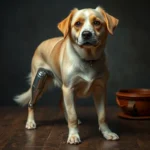
Introduction
As a pet owner, dealing with accidents is an inevitable part of having a dog. Finding dog urine in your home is crucial not only for maintaining a clean environment but also for ensuring the health of both your pet and your family. While many people turn to conventional methods such as using a blacklight to locate these accidents, there are alternative solutions that can be equally effective, if not more so. This article aims to explore various methods to detect dog urine without the need for a blacklight, providing you with practical strategies to keep your home fresh and clean.
Understanding Dog Urine
Composition of Dog Urine
To effectively find dog urine, it’s essential to understand what it is made of. Dog urine primarily consists of urea, creatinine, and uric acid. Urea is a waste product formed from the breakdown of proteins, while creatinine is a byproduct of muscle metabolism. Uric acid is an organic compound that can crystallize, leading to potential staining on various surfaces.
The composition of dog urine affects its detection. For instance, uric acid can be particularly stubborn, often remaining in the environment long after the odor has faded. This makes it essential for dog owners to utilize effective methods for locating and cleaning up these messes.
Why Finding Dog Urine is Important
Finding dog urine is not just about aesthetics; it carries significant health implications. Both pet and human health can be at risk due to the bacteria present in urine, which can lead to unpleasant odors and even allergic reactions. Additionally, undetected urine can cause permanent damage to carpets, floors, and furniture, resulting in costly repairs.
Common Signs of Dog Urine
Visual Indicators
One of the most apparent signs of dog urine is visible stains on carpets and floors. These stains may appear darkened or discolored, especially in lighter surfaces. Keep an eye out for any unusual discoloration in fabric, carpets, or even hardwood floors, as these often signal the presence of urine.
Odor Detection
The unmistakable smell of dog urine is another critical indicator. It has a strong, ammonia-like scent that can be more potent in areas where the urine has soaked in. To locate urine spots effectively, it’s essential to identify areas with a strong odor, which can help narrow down your search.
Behavioral Cues
Your dog’s behavior can also provide clues about where accidents have occurred. If your dog frequently sniffs or lingers in specific areas, it may indicate a past accident. Observing these behaviors can guide you in pinpointing where to focus your cleaning efforts.
Practical Methods for Finding Dog Urine Without Blacklight
Using Your Senses
Smell
One of the most straightforward methods for finding dog urine is utilizing your sense of smell. Get close to the ground and start sniffing around suspected areas. Pay attention to where the odor is strongest, as this will often lead you directly to the source.
Sight
Using your eyesight is another effective strategy. Look for any color changes in fabric, carpet, or flooring, which may indicate a urine stain. Natural light can be particularly helpful in highlighting these areas, so consider checking during the day when sunlight is streaming in.
Using Water
Another practical method for detecting dog urine is to dampen suspected areas with water. This technique works because urine typically reacts with water, causing stains to become more visible. Lightly mist the area with water and then blot it with a white cloth—if you see discoloration on the cloth, you’ve likely found urine.
Utilizing Household Items
Baking Soda
Baking soda is a versatile household item that can help both absorb odors and reveal stains. To use baking soda effectively, sprinkle it generously over suspected areas and let it sit for several hours or overnight. Once it’s dried, vacuum it up. If urine is present, you may notice that the baking soda has clumped together or absorbed a foul smell.
Vinegar Solution
A vinegar solution can also be beneficial in revealing dog urine. To create this solution, mix equal parts of water and white vinegar in a spray bottle. Spray the mixture on the suspected area and let it sit for a few minutes. The vinegar will help to lift the stain, allowing you to see whether it was caused by urine.
Commercial Products
If home remedies aren’t effective, consider turning to commercial products designed specifically for urine detection. Enzymatic cleaners are particularly useful as they contain enzymes that break down the components of urine, effectively eliminating both stains and odors. Look for products that are marketed as urine detectors or stain removers for the best results.
Preventing Future Accidents
Training Techniques
Once you’ve successfully located and cleaned up dog urine, it’s essential to prevent future accidents. Start with basic house-training techniques, which can include regular bathroom breaks and positive reinforcement for outdoor elimination. Establishing a routine helps your dog learn when and where it’s appropriate to go.
Creating a Designated Bathroom Area
Setting up a designated bathroom space can significantly reduce indoor accidents. If you have outdoor access, consider creating a specific area in your yard where your dog is encouraged to relieve itself. For indoor spaces, using pee pads can provide a consistent option for your pet. Consistency is key to establishing good bathroom habits.
Using Deterrents
There are various products and methods available that discourage urination in unwanted areas. Consider using commercial deterrents, which can be sprayed on specific surfaces to make them less appealing for your dog. Additionally, employing positive reinforcement techniques, such as treats or praise when your dog uses the correct bathroom area, can reinforce good behavior.
Conclusion
Finding dog urine effectively is vital for maintaining a clean and healthy home environment. The methods discussed in this article, including using your senses, household items, and commercial products, provide practical strategies for detecting urine without the need for blacklight. By implementing these techniques, you can ensure that your living space remains fresh for both you and your furry friend.
FAQs
What are some signs that my dog has urinated in the house?
Look for visual indicators like stains and discoloration, strong odors, and behavioral cues from your dog, such as lingering in specific areas.
Can I use baking soda to get rid of dog urine odor?
Yes, baking soda can absorb odors and reveal stains. Sprinkle it over the area, let it sit, and then vacuum it up.
Is vinegar effective for cleaning dog urine?
A vinegar solution can effectively lift stains and neutralize odors when sprayed on the affected area.
What should I do if I can’t find the source of the urine?
If home methods fail, consider using commercial enzymatic cleaners designed for urine detection.
How can I prevent my dog from urinating indoors?
Basic house-training techniques, creating a designated bathroom area, and using deterrents can help prevent future accidents.
By understanding how to locate dog urine and implementing preventive measures, you can maintain a clean and safe environment for your pet and family.









